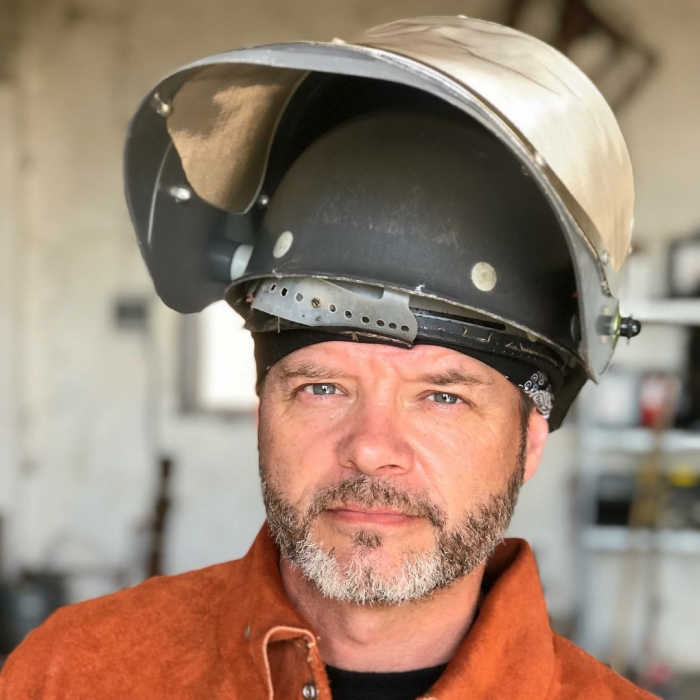Michael Baggarly
Associate Professor

Departments / Programs
Degree Information
- MFA, University of Iowa (2002)
- MA, University of Iowa (2001)
- BFA, Western Kentucky University (1999)
Biography
Michael Baggarly, an Associate Professor of Art and Design, teaches Three-Dimensional Design, Sculpture I, II, III, IV, V, and Advanced Art Problems.
Artist Statement...
Read More »Michael Baggarly, an Associate Professor of Art and Design, teaches Three-Dimensional Design, Sculpture I, II, III, IV, V, and Advanced Art Problems.
Artist Statement
I grew up observing my Grandfather. He made his living as a miner before being forced to retire due to the industry's considerable effect on his health. Afterward, his time was consumed at home, unable to do many of the things he had spent his life working at. In a chair in his front yard, he would sit for hours watching the world pass. During this time, he would often take a stick that had fallen from the large tree he sat beneath and use his pocketknife to carve it away slowly. He never made anything beyond the mass of shavings that covered the ground at his feet, but the true importance of this act was not what was produced but rather the process of making. Decades of disciplined hard work and labor had instilled a sense of repetition, routine, and redundant actions. I believe he found a sense of being within whittling activity, a quiet, almost spiritual process that echoed years of labor, daily struggle, and identity.
Teaching Philosophy
As an educator and artist, I am engaged in an active conversation about the possibilities offered within contemporary art. My view is nurtured through the framework for inclusive interactions from diverse experiences and areas. Artistically I am drawn to the details of concepts, actions, or forms drawn from the everyday. Pedagogically this sense for detail manifests itself within the determination to educate students that varied and complex aspects of living empower our work as artists and provides a richer experience as human beings. Art is not an exclusive practice but an inclusive one.
Teaching, like creating art, requires communicating complex ideas simply and clearly. It also establishes the responsibility of providing students with the tools necessary to move concepts forward within their chosen studies. Critical thinking, passion for knowledge, and the ability to evolve from concept to form are areas I stress in interactions with students. I motivate students to acquire the absolute power of problem-solving. Honing students' ability to formulate ideas and think critically allows an almost infinite avenue in which to explore the world. To do this, I focus on balancing art's mental and physical nature. Homework assignments, carefully chosen and designed, help to impart implicit knowledge and skills needed to grasp the fundamentals of the conceptual nature of sculpture. Physical hands-on experiences allow the opportunity to demonstrate how concepts and techniques formulate and evolve during the actual process of working.
I work on challenging and being challenged by students. Creating and thinking critically about art is not a spectator sport. Students cannot be passive recipients of knowledge. Within the nature of liberal arts-based programs, I teach students that to learn, one must be willing to do more than take notes and memorize information. Art students must continually challenge themselves to what art is and how it functions. Doing so means changing the mindset of passive assimilation that many students have developed. I do this by providing students the means to integrate personal experiences and practices within each studio assignment. I see active results from those who claim ownership of assigned projects. This claim engages a sense of responsibility that move beyond what is "assigned." Students are apt to push themselves beyond traditional limitations. They arrive at the end of the experience with a more acute sense of awareness as to who they are as an artist and as an individual. This commitment is developed by allowing students' unique backgrounds to surface, whether from a music major exploring ways to incorporate sound within a cast bronze form, a biology student merging empirical science within an installation, or an art student studying possibilities of combining printmaking and sculpture into a cohesive structure. It is a realization that we are more than the sum of our parts.
I continually stress that sculpture is more than stone or metal. Sculpture is an interdisciplinary program encompassing various materials, philosophies, and disciplines. In creating an effective learning environment, I create situations that push students beyond their expectations and limitations in the belief that, when given the opportunity, they are capable of outstanding personal achievement and artistic growth.
This observation, perhaps more than any other, shaped my relationship with the world. It establishes my sense of routine and focuses on cumulative acts. This need drives my work and manifests within the redundancy of hammer strikes, incised lines, or labor-intensive constructions. The pursuits of these actions provide me a sense of center that often remains elusive within the static of the everyday. These works are born in opposition to this environmental noise. I hope they meet the viewer in a manner that creates moments of quiet observation that provide a revelation toward each person's sense of being.
Creative Activity
See Baggarly's Work: Michael Baggarly Website


